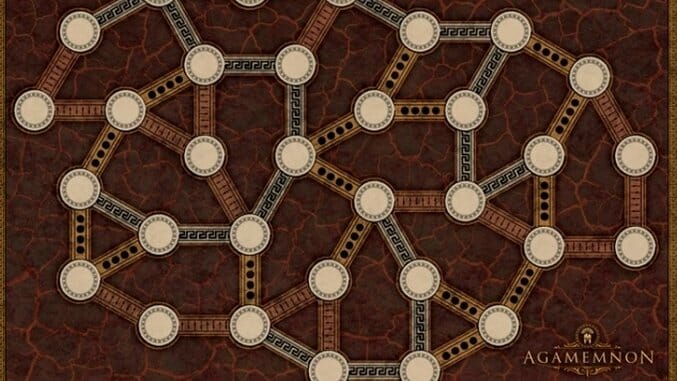Agamemnon is the New King of Short Two-Player Boardgames

Agamemnon was my favorite new game from this year’s Gen Con, an abstract, elegant two-player game that was easy to pick up but offers enough open-ended decision-making to give the game replay value. With a low luck factor and a couple of variants available in the base game, it seems destined to join the short but growing list of great, short-playing two-player titles (along with 7 Ronin) available to folks who don’t have time for a four-hour game night on a Tuesday evening.
Agamemnon’s main board is a hub-and-spoke network where there are three types of spokes, covered with little tiles called “strings” in three different patterns, forming chains across the board. Each player has fifteen tokens that s/he will place on the board, two per turn, to try to claim various chains and end the game with the most strings under his/her control. Because these string chains intersect, however, players will have to choose to cede control of certain chains to concentrate on claiming others—making blowouts nearly impossible—with just a few tokens available to try to sabotage one’s opponent.
The three string types are controlled in different ways by player tokens, which is the heart of all of the game’s strategic decisions. Most player tokens display anywhere from one to four spears, and the first string type is controlled by the player with the most spears on tokens within that chain. Each player has five leader tokens with a letter from A to E; the second string type is controlled by the player with the highest-ranking leader on the chain (A is highest; if there’s a tie, control goes to the second-highest rank). The third chain type just goes to the player with the most total tokens on the chain regardless of face value.
Each player also gets four tokens for sabotage or redirection of strings, changing the face of the board slightly to his/her advantage. Two of those tokens sever a chain at the token—a longer chain becomes two smaller ones with a break where the token lies. The other two allow the player to switch two adjacent string tiles on the board, breaking up chains or redirecting them, potentially allowing the player to shift control of a chain over to one of his/her own tokens.
